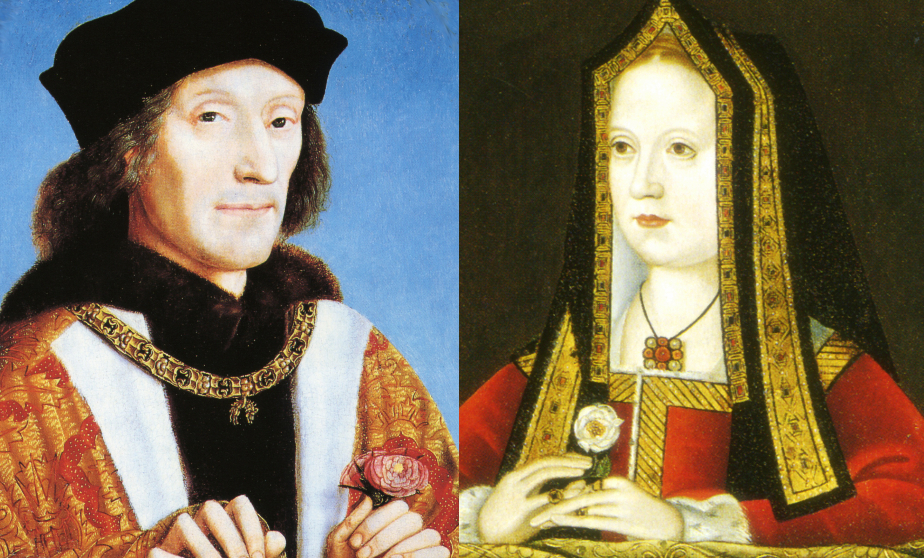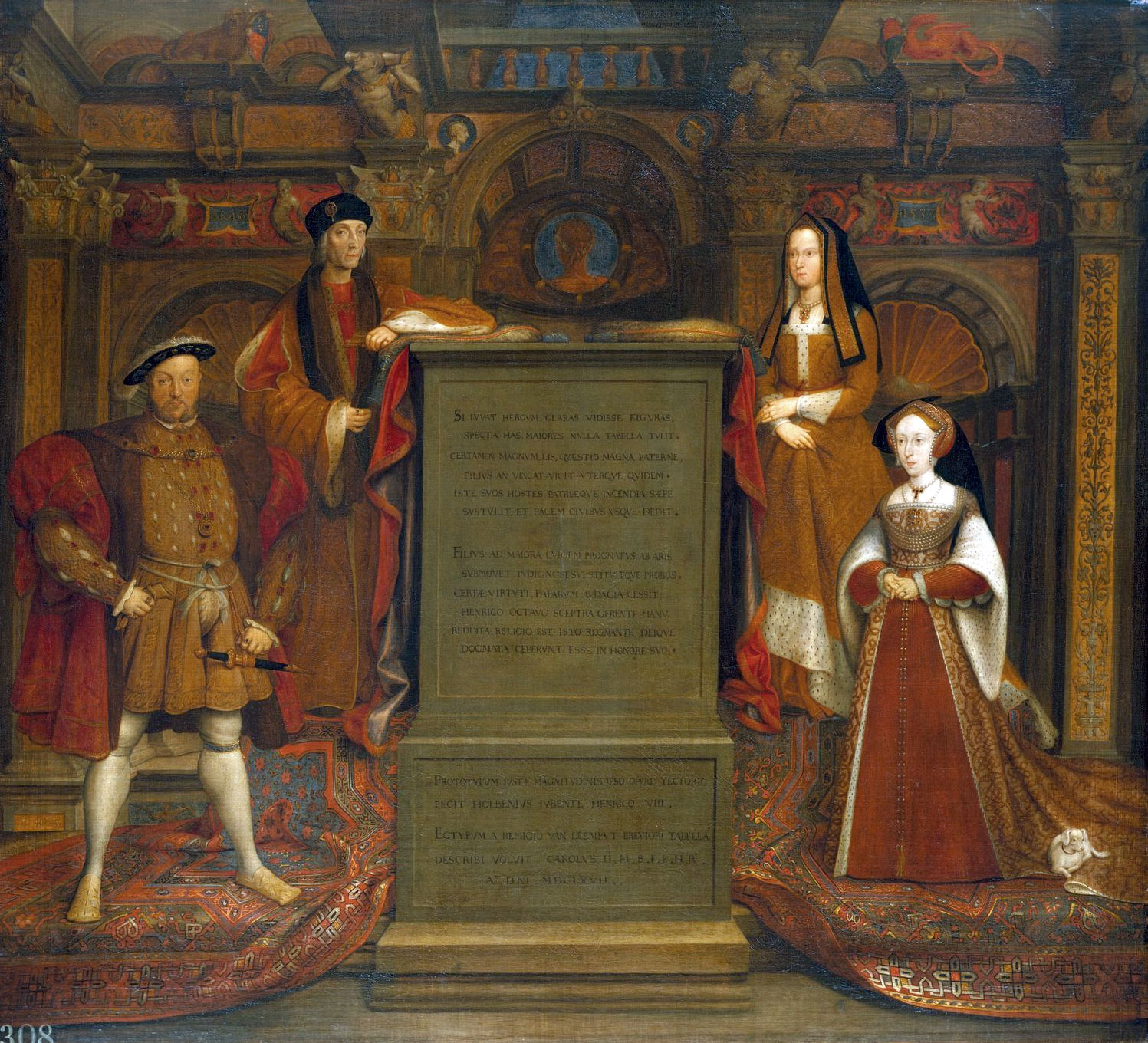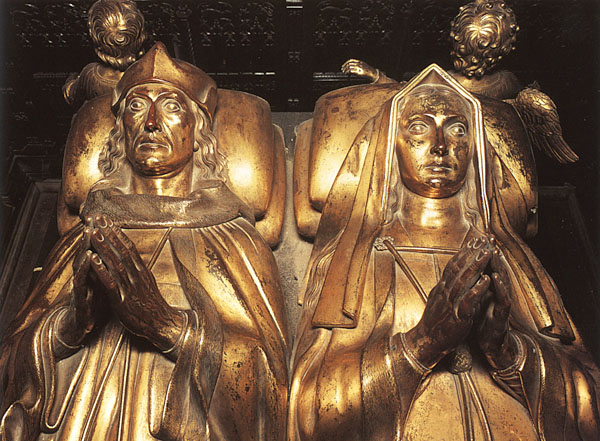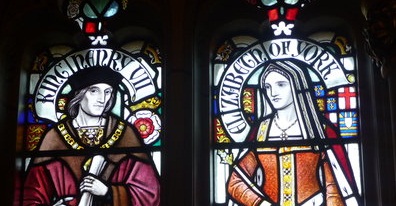If you’re here looking for the answer to that question: no. No, he didn’t. We don’t know for certain of course, but no. It is highly, highly unlikely that he did given that by the standards of the time Henry VII and Elizabeth of York had an affectionate and loving marriage.
As another blogger has said far more eloquently than I could have;
“Some Richard III admirers have sought to attribute any manner of cowardly and vile acts to Henry Tudor including forcing Elizabeth into his bed before the marriage to “test” if she was a virgin or the raping of his betrothed to see if she was fertile. To accuse Richard III of defiling his own niece or Henry Tudor of raping his betrothed needs to be considered only with the contempt it deserves.”
With that out of the way, presenting: the love story that was Henry and Elizabeth.
‘A Striking Couple’
When Elizabeth of York, the eldest child of King Edward IV, was five, the man who would become her husband was already heading into exile because her father had regained his throne. Henry Tudor, Earl of Richmond (or not depending on which colour rose sat on the throne) feared execution by the Yorkist king and so spent fourteen years in Brittany eluding him. Although Edward IV made some attempts to have him returned and executed, he also at one point drafted a pardon for him and was prepared to invite him back to England. There, the Yorkist Edward would have reconciled with the Lancastrian Henry and the possibility of marriage between Elizabeth and Henry was considered as a means to unite the warring houses. The possibility came to nothing, however, when Elizabeth was then betrothed to the Dauphin of France, a betrothal which was broken by the other party in 1482.
If Edward planned to revisit the idea of marrying her to Henry Tudor he never got the chance, as within a year he was dead and Elizabeth was taken into sanctuary by her mother. Edward’s son, also Edward, became Edward V, but the reign was short-lived as he and his brother disappeared from their home in the Tower, and their uncle became Richard III. Under Richard, Elizabeth and her siblings were declared illegitimate by an Act of Parliament, and her mother Elizabeth Woodville conspired with Henry Tudor’s mother to have them betrothed.

Henry pledged himself to marry Elizabeth on Christmas day of 1483 and shortly afterwards made a failed attempt to invade England. A second attempt in 1485 proved more successful and with Richard dead, Henry was declared King Henry VII of England. Henry was crowned before his marriage and there was some delay before he actually honoured his promise to wed Elizabeth. During this time she was lodged with his mother, Margaret Beaufort, and so she would almost certainly have seen her betrothed frequently. One of the first Acts of Henry’s first Parliament was to assert Elizabeth’s legitimacy which was necessary to establish before they married. Also necessary was papal dispensation to account for the blood relations between the two and two days after the dispensation arrived Henry and Elizabeth were married at Westminster Abbey.
Elizabeth of York was noted for her beauty, with her fair hair and pale skin the very model of ‘an English rose’. While Henry VII is not similarly known for his looks, at the time of his marriage, he is described as being quite attractive, and the two were thought to make ‘a striking couple.’ Although he had married her it would still be over a year before Henry would have her crowned Queen, with the event delayed by pregnancy and later, rebellion.
There is some dispute over when Elizabeth fell pregnant. Their first child, Arthur, was born on the 20th September 1486, almost eight months to the day of their wedding. Elizabeth might have been pregnant at the time of her wedding, or Arthur might have been premature (as some of his siblings would later be). Either way, it showed that Elizabeth had fallen pregnant quickly, a promising omen for a Queen. It’s not known how many pregnancies Elizabeth had in total, but she had at least seven children, though only four would survive infancy.
‘A Faithful Love’
Pregnancies aside, Henry and Elizabeth seem to have had an affectionate relationship. They were never very far from each other, the exception being when Henry put down a rebellion while Elizabeth was having Arthur. Henry refers to Elizabeth fondly in letters and while very few letters of Elizabeth’s survive in one of them she calls Henry her, “most serene lord, the king, our husband.” In lieu of letters, we have poetry written by Elizabeth, in which her happiness at her situation is evident in each example, where her personal joy forms the theme of each poem. Elsewhere there is an affectionate account of a disagreement between the two where Henry asked that he might have copies of letters from Catherine of Aragon and her parents, to which Elizabeth refused, claiming that one copy was for their son Arthur and she was quite happy keeping the other copy to herself. Perhaps it was because of the loving example set to them by their parents that the surviving Tudor children would take a relatively novel approach to marriage, with all three of them defying protocol to marry for love at various points.

There is speculation that Elizabeth conflicted with Henry’s mother, Margaret Beaufort, who was (besides the Queen herself) the first lady at court. The reason this is speculation is that if she was in competition with her mother in law it wasn’t an obvious one and there is more evidence showing the two in harmony than at odds. I mentioned that Elizabeth lived with Margaret before her marriage and the two would continue to be in close quarters (probably out of necessity rather than affection). When Elizabeth took issue with Henry’s proposals for their daughter Margaret’s marriage, it was to his mother that she appealed, and it was together that they confronted Henry.
Although Henry has an image of being a sombre miser, this is something exacerbated by Elizabeth’s death. Beforehand his privy purse records show that he was generous with gifts to his wife, at one point purchasing a lion for her amusement. It has also been suggested that he kept Elizabeth impoverished and that she had to continually mend her gowns, but again his expenses suggest otherwise. She did indeed retain a tailor to mend her dresses, but he also gifted her new ones. When she found herself in debt (owing to her generous and charitable nature rather than excessive spending habits) he, of course, paid them, and it should probably be noted that for a king who was so concerned with pageantry to establish the legitimacy of his dynasty, to keep his queen in rags and poverty would have been quite damaging.
‘Painful Sorrows’
On April 4th, 1502 Henry was woken in the early hours of the morning by his confessor, bearing the news that his eldest child Arthur had died two days previously. Aside from the obvious grief at the loss of his son this also had implications for Henry’s legacy. Arthur had recently been married to Catherine of Aragon to cement Anglo-Spanish relations, something which would clearly be affected by his loss. Then there was the fact that Henry only had one other son, Henry, who was at the time just ten years old and had in no way been prepared for the possibility of kingship.
Henry’s first reaction to the news was to immediately send for Elizabeth so that they could share the news. I think this is interesting to consider; that he didn’t have to break the news to her personally and he wasn’t doing so just to inform her, but that they could react together and take comfort in each other. The exchange shows just that. Without being told as much, Elizabeth realises that Henry’s grief is as much in the implications for their legacy than their lost son, and she comforts him regarding it. After she had returned to her chambers and broken down herself, Henry comes to her and comforts her in much the same way.
“When his Grace under- stood that sorrowful heavy tidings, he sent for the Queen, saying that he and his Queen would take the painful sorrows together. After that she was come and saw the King her lord, and that natural and painful sorrow, as I have heard say, she, with full great and constant comfortable words besought his Grace that he would first after God remember the weal of his own noble person, the comfort of his realm, and of her. She then said, that my lady, his mother, had never no more children but him only, and that God by his grace had ever preserved him, and brought him where that he was. Over that, how that God had left him yet a fair prince, two fair princesses ; and that God is where he was, and we are both young enough ; and that the prudence and wisdom of his Grace sprung over all Christendom, so that it should please him to take this according thereunto. Then the King thanked her of her good comfort. After that she was departed and come to her own chamber, natural and motherly remembrance of that great loss smote her so sorrowful to the heart, that those that were about her were fain to send for the King to comfort her. Then his Grace, of true, gentle, and faithful love, in good haste came and relieved her, and showed her how wise counsel she had given him before ; and he, for his part, would thank God for his son, and would she should do in like wise”
There is much more in this exchange than simply duty between husband and wife, or cordiality between a royal couple. It had been three years (as far as we know) since Elizabeth had carried a child, (Edmund – who died at a year old) and her comments that they were ‘both young enough’ suggests that they might have already decided not to try for more children. With the future of the dynasty in question, Elizabeth had fallen pregnant within a few months of Arthur’s death. In early 1503 she went into confinement in the Tower of London, but the baby came prematurely. Some weeks before expected Elizabeth went into labour, which was apparently a difficult one and the Queen became feverish. Unusually, we find Henry not waiting for news at one of his palaces, but actually pacing outside the chambers. When he heard that the Queen was ill he immediately dispatched summons to specialist doctors across London to attend her. The baby was born a girl on the 2nd February 1503, named Katherine for her widowed sister in law but unfortunately, died eight days later on the 10th. Elizabeth’s fever deteriorated after the birth and she died a day after Katherine on the 11th February, her thirty-seventh birthday.
‘A Solitary Place’

It is Henry VII’s reaction to Elizabeth’s death that is the strongest case to show the depth of affection they shared. He ordered a lavish funeral for his wife and leaving the arrangements in the hands of his mother, he departed for Richmond Palace and once he reached his privy chambers, he broke down and collapsed with grief. Henry was known for being private and reserved, rarely given to public displays of emotion and so it came as a shock to his attendants that he should show his grief so openly. They did not get the chance to marvel long, for he soon dismissed them and intended to grieve in private. Very quickly became ill himself, but to the further alarm of his court, he would not allow any doctors to see him and he continued to refuse assistance. In the end, it was his mother who nursed him back from the brink; the only person that he would admit to his presence.
If this was a reaction to the blow this struck to the Tudor dynasty you would think Henry would be at pains to remarry quickly so that he might beget more children. Henry, who had been apparently faithful to Elizabeth during their marriage, did not marry again, nor did he pursue potential marriage negotiations with any particular fervour. The closest he came to a second marriage were his enquiries to Joanna of Naples and later, Joanna of Castille. Initially, he seemed to have designs to marry his son’s widow, Katherine, and the papal dispensation that would allow her to marry his surviving son was altered to allow her to marry him instead. This might have been a reaction out of grief, as he did not pursue her with any enthusiasm and later used her to advance negotiations with her sister, Joanna of Castille.
After Elizabeth’s death, the court’s reputation for charity diminished considerably, along with Henry’s gifts to his children and the king’s demeanour. If he had a reputation for avarice before, now he was positively mean. Elizabeth was mourned deeply by her family and Henry had the Tower of London abandoned as a royal residence; he did not lodge there for the rest of his life. He remembered his wife every year and on February 11th bells were rung, masses were sung and a hundred candles were lit in her memory.
Henry survived Elizabeth by six years, but her loss had aged him considerably. He suffered recurring bouts of illnesses after his initial collapse when he lost his wife, and in early 1509 he fell ill for the last time. Once again he retreated to Richmond allowing very few people near him, though he did break his tendency of frugality by donating a sum of money to ‘women in childbed’, a somewhat random bequest but poignant given the manner of Elizabeth’s death. Suffering from tuberculosis Henry declined quickly and died on 21st April 1509. He was, of course, buried beside Elizabeth.
If you’d like to join me for more fun and games in picking apart history, and other behind the scene tangents, you can support me via my Patreon.













